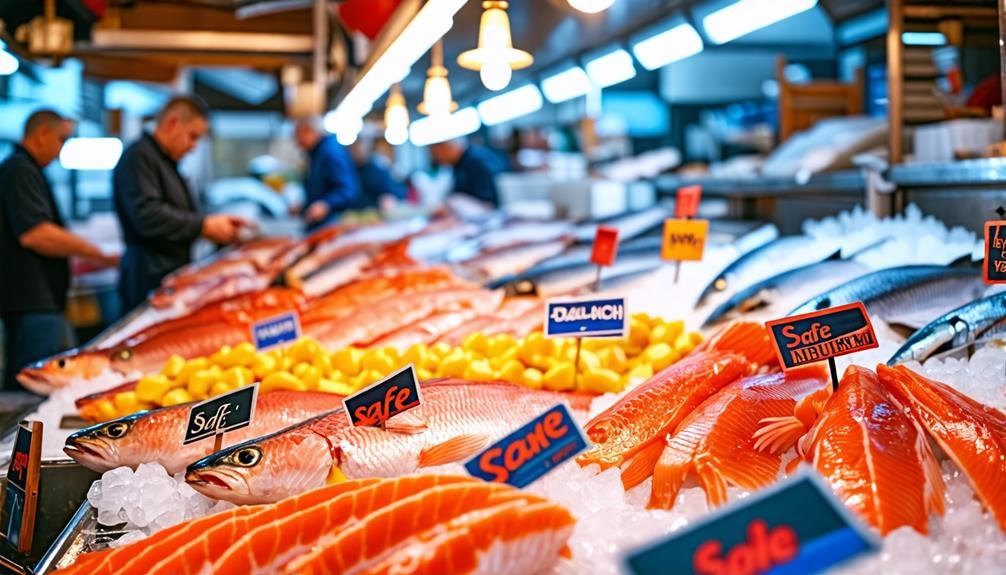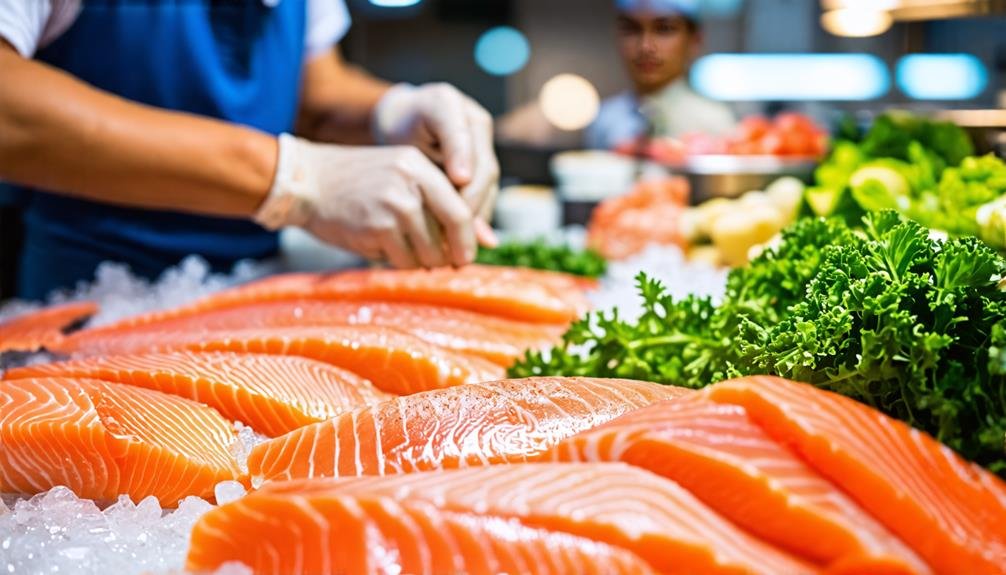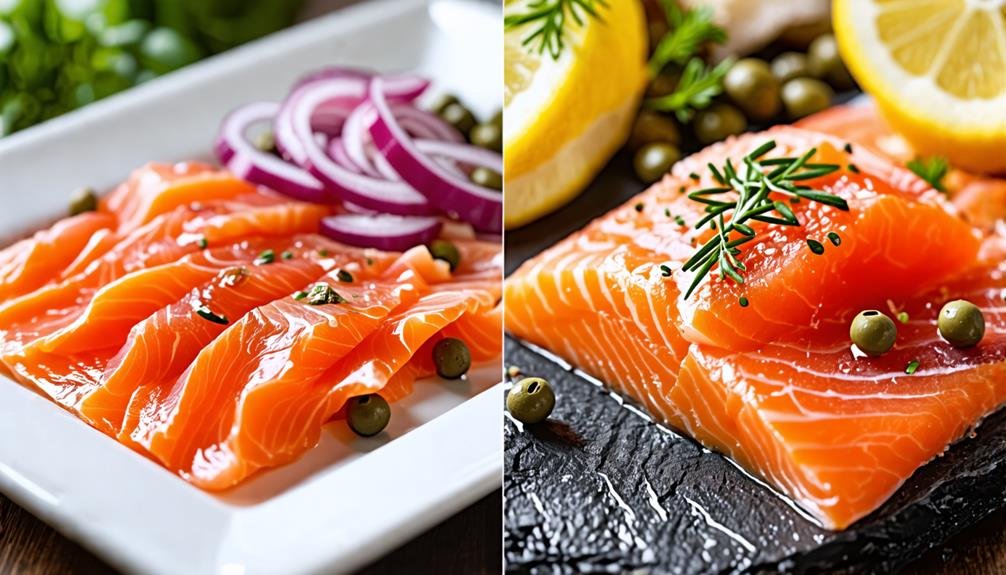Investing in high-quality raw fish is essential for your safety and culinary enjoyment. Superior fish, sourced from reputable fishmongers, greatly reduces the risk of foodborne illnesses and parasites. Premium selections like salmon and tuna offer not only superior flavors but also guaranteed freshness, indicated by vibrant colors and firm textures. A higher price often reflects meticulous sourcing and handling practices, ensuring a safe dining experience. By spending a little more, you protect your health while enhancing your meals. Interested in how to choose the best fish and what to look for at the market? There's plenty more to explore!
The Importance of Quality Fish
The quality of seafood is essential for its safety when consumed raw. High-quality sourcing minimizes the risk of foodborne illnesses. When preparing sushi at home, investing in premium seafood is a smart decision. Cheaper options might compromise your health and enjoyment. Choose high-grade options like Sockeye salmon, Atlantic mackerel, European seabass, or specific varieties of Bluefin tuna. These not only offer superior flavor but also enhance safety for raw consumption.
To ensure the safety of raw seafood, focus on freshness and visual appeal. Select plump, firm fillets with clear eyes and a mild scent. These characteristics can significantly enhance your sushi experience while lowering health risks.
For home sushi preparation, consider purchasing whole fish from reputable markets like Whole Foods or local fishmongers, who can expertly fillet it for you. This method ensures proper handling and minimizes contamination risks. By prioritizing high-quality seafood, you safeguard your health and elevate your culinary experiences. Dive into the world of sushi confidently, knowing your choices reflect a commitment to quality and safety!
Choosing a Trusted Fishmonger
Finding a reputable seafood vendor is crucial for ensuring the quality and safety of raw fish. Their sourcing practices significantly influence the freshness and integrity of the seafood you buy. A trustworthy fishmonger not only provides premium fish but also shares details about its origin, which is essential for raw consumption. Look for a seller who emphasizes sustainable sourcing and is open about their practices.
When choosing a fishmonger, engage in conversation. Inquire about their suppliers, handling procedures, and storage methods. A knowledgeable vendor, like Whole Foods or local markets, will be eager to share this information, giving you confidence in your selections. Visiting shops in person allows you to evaluate the fish's appearance, scent, and overall quality directly.
Identifying Safe Fish Varieties

When selecting safe fish varieties for raw consumption, quality is paramount. Opt for popular choices such as salmon, mackerel, seabass, and certain types of tuna, known for their freshness and flavor. By focusing on high-quality fish sourced from reputable fishmongers, you not only improve your culinary experience but also reduce the risks associated with eating raw fish.
High-Quality Fish Selection
Choosing safe fish varieties for raw consumption is vital. Salmon, mackerel, seabass, and specific types of tuna are recognized for their quality and lower parasite risks. These fish not only excite the palate but also provide reassurance for culinary enthusiasts eager to explore raw seafood. When selecting fish, prioritize those with vibrant colors and firm textures, as these traits often indicate freshness.
Sourcing fish from reputable suppliers, such as Whole Foods or local fish markets, is essential. Look for plump, whole fish with clear eyes and no off-putting odors. These characteristics suggest proper handling and storage. It is wise to request whole fish and have them filleted on-site, ensuring you receive the freshest cuts available.
Although high-quality fish may carry a higher price tag, consider it an investment in your health and dining experience. Embrace the chance to enjoy safe, raw fish, enhancing your meal while reducing health risks. Remember, the pleasure of indulging in raw fish comes from knowing you've selected the finest options!
Safe Raw Fish Types
Certain fish varieties, such as Atlantic salmon, Pacific mackerel, European seabass, and specific species of bluefin tuna, are widely regarded as safe and suitable for raw consumption. These fish not only provide great flavor but also present lower risks associated with parasites and bacteria, making them excellent selections for sashimi or sushi lovers.
When selecting fish for raw dishes, it is essential to find reputable suppliers. Look for fish that displays vibrant colors and freshness, with firm flesh and bright, clear eyes. Avoid any fish that exhibits gray tones or a slimy texture, as these are signs of aging and reduced quality. If available, opt for farm-raised varieties, as they typically have fewer parasites compared to their wild-caught counterparts.
Visiting a local fish market, like Whole Foods or your neighborhood seafood store, can be an informative experience. Interact with the fishmongers, inquire about the sourcing and handling practices of their fish. Spending a bit more on high-quality options not only enhances your culinary experience but also ensures that you are taking necessary health precautions. Ultimately, enjoying raw fish can be an exciting culinary journey—just be sure to make wise choices to savor every bite safely!
Recognizing Freshness in Fish
Evaluating the freshness of seafood is essential for ensuring safety and quality, particularly when considering raw dishes. Fresh fish enhances your culinary experience and reduces health risks associated with uncooked seafood. Here are three critical indicators for assessing freshness:
- Appearance: Seek out vibrant hues. Fresh salmon or tuna should display a bright sheen and firm texture, free from dull or grayish tones. Excessive slime is a warning sign!
- Eyes: The eyes of the fish, such as cod or halibut, should appear clear and bulging; cloudy or sunken eyes suggest aging. Consider this the fish's way of indicating, 'I'm not as fresh as I should be!'
- Odor: A fresh fish, like snapper or trout, should emit a clean, briny aroma reminiscent of the ocean. If the scent is overly fishy or sour, it's best to avoid it.
The Risks of Raw Fish Consumption

Consuming raw fish can be an thrilling culinary experience, but it does come with its share of risks that must not be overlooked. Parasitic infections, particularly from tapeworms, pose a vital threat, making quality sourcing and safe handling practices crucial for enjoyment. By prioritizing high-quality fish and being mindful of how it is prepared, you can notably reduce these health risks and savor the delicious flavors of raw fish with confidence.
Parasitic Infections Awareness
Consuming raw seafood, like sushi and sashimi, can expose you to dangerous parasites that pose serious health risks if not handled and sourced properly. Awareness of these health threats is essential for enjoying these culinary delights safely.
Here are three important considerations:
- Prevalent Parasites: Raw seafood can contain parasites such as Anisakis and various tapeworms, which may cause gastrointestinal issues and more serious health concerns if ingested.
- Signs of Infection: Symptoms including nausea, stomach pain, or vomiting after eating raw seafood could signal a parasitic infection. It's important to seek medical help immediately if these symptoms occur.
- Quality is Key: The source of your seafood plays a crucial role in your risk level. Opt for trusted seafood suppliers who emphasize safe sourcing practices to reduce your chances of infection.
Safe Handling Practices
Understanding the dangers of raw fish consumption is crucial, as safe handling methods significantly reduce the risk of foodborne illnesses. When enjoying raw fish, such as sushi or sashimi, cleanliness is essential. Always wash your hands, utensils, and surfaces thoroughly before and after handling fish. This simple practice can greatly diminish cross-contamination risks.
Additionally, keep raw fish, like salmon or tuna, refrigerated at temperatures below 40 degrees Fahrenheit to prevent harmful bacteria growth. It's important to consume raw fish quickly, ideally within 24 hours of purchase. If you are preparing dishes at home, ensure your cutting boards and knives are exclusively used for raw fish to lessen contamination chances.
Investing in high-quality, sustainably sourced fish from brands like Blue Apron or FreshDirect makes a difference, but careful handling is equally important. Avoid shortcuts; a moment of carelessness can lead to severe health repercussions. Enjoy the pleasure of raw fish with the assurance that safe handling techniques empower you to savor this delicacy responsibly. Remember, your well-being is worth the effort, and with proper precautions, you can relish the unique flavors of raw fish without concern!
Quality Sourcing Importance
Sourcing high-quality seafood, particularly fish for sushi and sashimi, is essential for minimizing health risks. When fish is improperly sourced, it can expose consumers to harmful parasites and bacteria. Here's why prioritizing quality matters:
- Avoiding Parasite Risks: Premium fish, such as those from trusted suppliers like Bluefin Tuna Co., are less likely to contain dangerous parasites, including Anisakis worms, which can lead to severe health complications.
- Ensuring Bacterial Safety: Fresh fish from reputable sources, like Whole Foods Market, are handled and stored under strict hygienic conditions, significantly reducing the likelihood of bacterial contamination that can cause foodborne illnesses.
- Enhancing Flavor and Texture: High-grade fish not only promotes safety but also elevates the culinary experience, offering a more flavorful and enjoyable meal, akin to the exquisite dining at a top sushi restaurant like Nobu.
Investing in quality seafood is about more than just health; it enriches your dining experience. A knowledgeable fishmonger from a reputable establishment can assist you in selecting safe and delicious options, ensuring that each bite is both delightful and secure. Remember, enjoying raw fish entails a responsibility to choose wisely. Embrace the quest for that ideal, high-quality fish!
Safe Handling Practices for Raw Fish
Safe handling practices are essential to reduce the chance of foodborne illnesses when preparing seafood for raw consumption. Start your culinary adventure by ensuring your workspace is spotless and your utensils are sanitized. Use distinct cutting boards for raw fish, like salmon or tuna, and other ingredients to prevent cross-contamination.
Upon receiving your seafood, it's important to maintain the correct storage temperature. Keep it in the coldest section of your refrigerator or on ice until you're ready to prepare it. This helps preserve its freshness and quality. While preparing your fish, observe its texture and color; fresh salmon, for example, should appear plump and have a bright hue.
When you begin to slice that exquisite fillet, use a sharp knife for clean cuts. This not only enhances the presentation but also inhibits bacterial growth. Finally, if you have any leftover seafood, consume it quickly or store it correctly for future use. By adhering to these safe handling practices, you can savor the experience of enjoying sushi and sashimi with confidence, knowing your health is safeguarded. Dive into the world of raw fish dishes, like those offered by renowned brands such as Nobu or Bluefin, without compromising your well-being!
Questions to Ask Your Fishmonger

When seeking top-notch raw fish, asking the right questions at your fishmonger is crucial for ensuring both freshness and safety. Inquire about their sourcing practices and look for indicators of freshness, such as vibrant colors and firm textures. Engaging with your fishmonger not only enriches your knowledge but also deepens your appreciation for the quality seafood on your plate.
Sourcing Practices Explained
Asking your fishmonger about sourcing practices is crucial for ensuring the fish you buy is safe for raw consumption. Engaging in this conversation enables you to make better choices, enhancing your dining experience.
Consider these three important questions:
- Where is the fish from? Knowing the source of the fish can reveal its quality and safety. Reputable fishmongers will share details about their suppliers.
- What catching or farming methods are used? The techniques employed can affect the fish's health and safety. Choose fishmongers that emphasize sustainable and ethical sourcing.
- How is the fish handled after being caught? Proper handling is vital for maintaining the fish's quality. Inquire about temperature control and storage practices to ensure you are buying the freshest fish possible.
Freshness Indicators to Check
To guarantee that the seafood you buy is fresh and suitable for raw consumption, it's crucial to engage your fishmonger with targeted inquiries about freshness indicators. Begin by asking for the catch date of the fish. Ideally, it should be no older than two days. Then, seek details about its preservation conditions—was it stored on ice, and at what temperature? These factors significantly influence its quality.
Don't hesitate to inspect the fish yourself. Fresh specimens should have clear, bright eyes and vibrant scales—hallmarks of freshness. When you touch the fish, it should feel firm and should not emit any unpleasant odors; rather, it should exude a clean, ocean-like aroma. If you're looking at fillets, ensure they appear moist without any signs of browning or dryness.
Benefits of High-Quality Fish
Investing in premium seafood not only elevates the flavor of raw dishes but also mitigates health risks linked to foodborne pathogens. The distinction in quality can revolutionize your dining experience, allowing you to relish each morsel while feeling assured in your selections. Here are three persuasive advantages of opting for high-quality seafood for raw consumption:
- Superior Flavor: Premium seafood delivers a fresh, vibrant taste that enhances delicacies such as sushi or sashimi, creating a memorable dining experience.
- Reduced Health Hazards: Purchasing from trusted suppliers like Whole Foods or local fish markets ensures that the seafood has been properly handled and stored, significantly lowering the risk of harmful bacteria or parasites.
- Promoting Sustainability: Choosing premium seafood often supports eco-friendly fishing methods, ensuring that your culinary enjoyment positively impacts marine conservation efforts.
Why Price Reflects Safety

The link between cost and safety in seafood is clear. Higher-quality fish, like salmon from Wild Alaskan Company or mackerel from Blue Horizon, often commands a premium price due to stringent sourcing and handling protocols that ensure its safety for raw consumption. When you opt for these pricier selections, you are securing not just the fish, but also extensive safety measures designed to protect your health.
Top-tier fishmongers, such as Whole Foods Market, follow strict sourcing guidelines, ensuring their seafood meets exceptional safety criteria. These measures significantly lower the chances of parasites and contaminants, which can lead to serious health issues when consuming raw varieties. For example, fish such as seabass from Santa Monica Seafood and specific tuna types from Fishmonger are typically priced higher, reflecting their superior quality and the meticulous care involved in their handling.
Furthermore, reputable fishmongers emphasize freshness, showcasing vivid colors and firm textures. This meticulousness assures you that the seafood you're purchasing is not merely a meal; it is a safe and enjoyable culinary experience. While the price may be elevated, selecting high-quality fish is a wise choice for relishing raw delicacies without jeopardizing your health. Seize the chance to indulge safely!
Enjoying Raw Fish Responsibly
Savoring raw fish with care involves a dedication to acquiring top-tier, safe selections from trusted seafood purveyors. This exquisite dining adventure depends on your decisions, ensuring each morsel is both delicious and secure. Here are three essential tips for a wise indulgence:
- Select Your Seafood Carefully: Favor species celebrated for their safety when enjoyed raw, like Atlantic salmon, Pacific mackerel, and sushi-grade yellowfin tuna. These options generally present lower risks of parasites and are frequently farmed under controlled conditions.
- Evaluate Freshness: Seek out fish that is plump and firm with striking colors. Fresh seafood should exhibit clear eyes and a crisp ocean aroma, steering clear of any dull tones or excessive slime, which signify age.
- Communicate with Your Seafood Specialist: Feel free to inquire! A skilled fishmonger, such as those at Whole Foods Market or local seafood markets, will eagerly explain sourcing methods and preparation techniques, ensuring you select premium ingredients.









